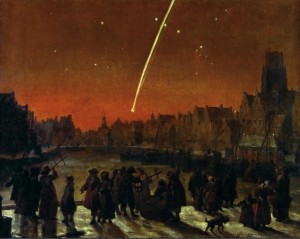(Posted 30 September 2012) With still just over two months to go until the end of 2012, it is already time to rush out and purchase a 2013 diary! The discovery of Comet 2012 S1 (ISON) on 21 September 2012 has set the comet observers emails lists abuzz with excitement centred on discussions on how this comet could potentially perform next year – the early calculations indicate that the comet could potentially rival the Full Moon in brightness. There is also a very high possibility that Comet 2012 S1 (ISON) is either the ‘Great comet of 1680’ or at least a fragment of it according to the famous comet observer John Bortle – due to the similarities between the two comets orbits.

Comet 2012 S1 (ISON) is currently located beyond the orbit of Jupiter and will a magnitude of +18 is too faint to be visible even through a typical large amateur telescope (to the eye). This is expected to change dramatically in November 2013 when it will pass less than 0.012 AU (1.8 million km) from the apparent surface of the Sun with perihelion occurring on 28 November 2013. Around this time the comet could potentially reach magnitude -16. Depending on how the comet behaves, it will become visible in the daytime sky. Post perihelion the comet will sadly move high into the Northern hemisphere sky becoming a circumpolar object at its closest approach to the Earth around Christmas 2013.
For Southern hemisphere observers, the visibility of Comet 2012 S1 (ISON) unfortunately reminds me a bit of the little I saw of Comet Hale Bopp in 1997. I can remember standing up with friends looking disappointingly at Comet Hale-Bopp through binoculars in the bright evening twilight from Beechmont in the Gold Coast hinterland. We got a glimpse of Comet Hale-Bopp as an unimpressive blog with a short stubby tail before it disappeared behind the Sun and became a bright Northern hemisphere comet. Comet 2012 S1 (ISON)’s orbital path means that a similar pattern of performance is likely. Another words, Comet 2012 S1 (ISON) has the potential to be the comet of the millennium but you will have to go North to see it.
I will upload a more detailed post about this comet during the coming weeks.
Me and my boyfriend go to beechmont whenever there’s meteor showers or to use the telescope!!! Amazing place! Hoping ISON will be visible for Australia. I feel like we’re always missing out!! 🙁